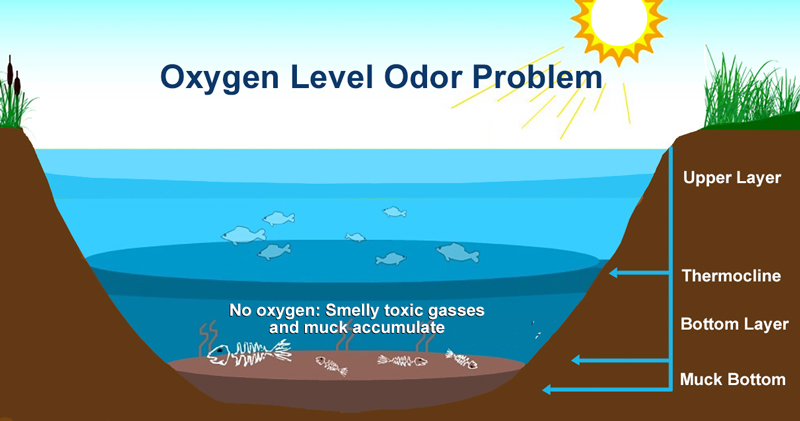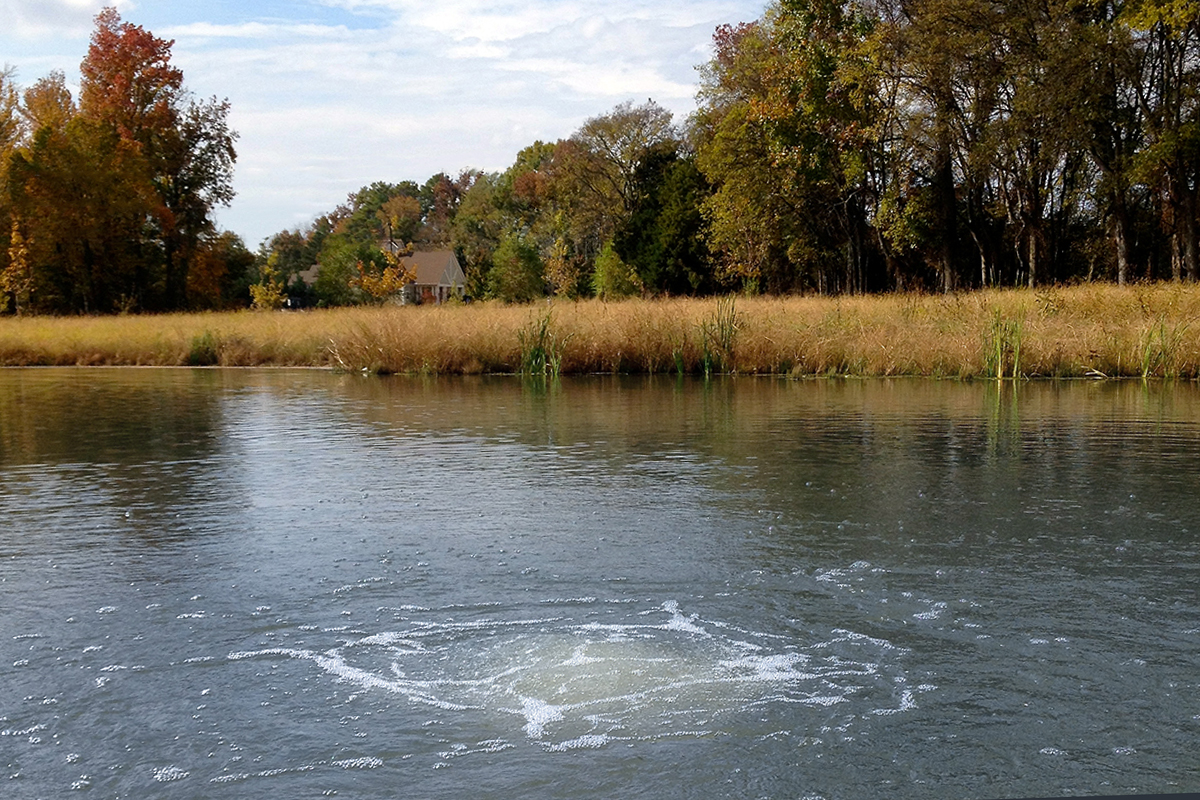Stop Pond and Lake Odors at the Source
Properly Sized Aeration Eliminates the Rotten Egg Reek
-By Dr. Josette La Hée, Senior Environmental Research Consultant
Have you noticed pond or lake odors that smell like rotten eggs? When there is plenty of oxygen in your pond either naturally or from a properly sized aeration system, anaerobic bacteria will step in and breakdown the organic material. But, as they do it, they will give off hydrogen sulfide, the cause of the smell.
You’ll breathe easier when your lake can breathe too
Temperature, water depth and water circulation all affect the oxygen levels in a pond. In general, wind blowing over the surface of the pond will circulate and mix the water in shallow ponds. This circulates oxygen throughout the whole pond. Also, oxygen producing organisms (e.g. plants or algae) in the water can supply the pond with significant amounts of oxygen. Oxygen throughout the whole pond means aerobic bacteria can effectively breakdown organic matter so there are no pond or lake odors.
Deeper ponds are much different. If a pond is deep enough, it can have distinct layers of water. Temperature changes drive the division of water layers called stratification.
In a summer stratified pond, there are at least two distinct water layers
The top water layer has warmer water, more light, and less organic matter than the bottom layer. Although the water in the top layer is warm and holds less oxygen, the smaller amounts of organic matter mean less oxygen is being used up by bacteria working to breakdown this material. In addition, the oxygen levels in this water layer remain high because they are constantly replenished by
- Absorption of oxygen from the air directly above the pond
- The oxygen produced by plants and algae as they photosynthesize.

If oxygen levels remain high, then oxygen-needing bacteria dominate, and in the absence of non-oxygen-needing bacteria, there is no buildup of hydrogen sulfide and so there is no odor.
The bottom layer of water is cooler and darker than the surface and sits above the sediment, which is where most of the organic matter lies. Oxygen-needing bacteria in the bottom layer work to breakdown organic matter. They use up the available oxygen quickly and no more oxygen can be added to this layer because:
- It is too dark for plants or algae to photosynthesize and produce more oxygen
- It is cut off from the surface water , so no oxygenated surface water can be mixed into the lower water layer.
This is why, even though the bottom water is cooler than the top, it holds less oxygen. Once most of the oxygen becomes depleted, the non-oxygen-needing bacteria take over. As they breakdown organic material, they release hydrogen sulfide. Over time, hydrogen sulfide builds up in the lower water layer and it is trapped as long as the pond remains stagnant.
Pond and lake odors take over in stagnant and stratified water
In stratified ponds, that layer of stinky water stays locked up at the bottom, becoming more saturated with hydrogen sulfide. As the warm summer gives way to cooler fall temperatures, the surface water cools, its density increases, and it starts to sink to the bottom of the pond. This mixing cycle, referred to as turnover, forces the water at the bottom of the pond up.
The mixing of the surface and lower waters causes the release of the once trapped hydrogen sulfide and results in a mass emission of very foul gas and an unpleasant October surprise. In addition to the foul smell, this mixing can also cause fish kills, algae blooms and other problems.
How you can avoid the problem – properly sized aeration !
The best way to avoid the problems associated with seasonal turnover is to prevent your pond from stratifying in the first place by encouraging consistent water mixing all year round. While the water of shallow ponds can be mixed just by wind action, deeper ponds may need some help to get the job done. Many people use artificial methods to help with water circulation. The most common of which is aeration.
What exactly is Aeration and how does it control pond and lake odors?
Aeration refers to the pumping of pressurized air into a pond at strategic points, which forces the water in the pond to circulate. Constant circulation prevents stratification and eliminates the buildup of hydrogen sulfide in the hypolimnion. A properly sized aeration system also consistently forces oxygen-rich surface water to circulate throughout the pond, which results in an even distribution of oxygen throughout the water column. This oxygen rich environment favors the growth of aerobic bacteria and makes it possible for them to consistently breakdown organic matter without the risk of running out of oxygen. As long as circulation continues, oxygen will remain available, anaerobic bacteria will remain at bay and there will be no rotten egg odor.
Enjoy Being Around Your Pond or Lake Again
About Dr. Josette La Hée, Senior Environmental Research Consultant
Dr. La Hée conducts research on urban aquatic ecology. The primary focus of her research is the use of sustainable management techniques for restoring impaired lakes and ponds. Dr. La Hée spent three years running lake aeration studies on multiple lakes throughout Florida. Additionally, she developed the lake assessment and monitoring protocols. In addition to research, Dr. La Hée conducts teaching and training sessions for lake management groups. She has presented research at conferences including the North America Lake Management Society and the Florida Aquatic Plant Management Society.
Vertex Aquatic Solutions, founded in 1977, is the professionals’ choice for research based scientific consulting services, aeration systems, floating fountains, bubble curtains and biological products to enhance water quality in lakes, ponds, canals, marinas and reservoirs. As respected leaders in the lake management industry the Vertex team of aquatic biologists, limnologists, fisheries scientists and engineers work together to deliver science-based, environmentally sound solutions to complex waterbody issues. Our products and services are delivered through an international network of qualified, experienced waterbody professionals who provide local support, service and pond management expertise to customers.
← Previous

